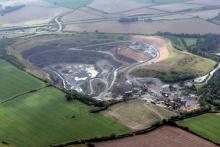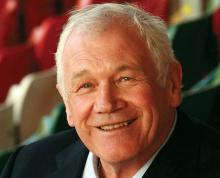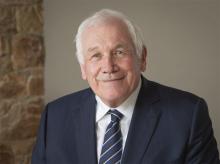
Breedon Aggregates has made steady progress since its formation in 2010, and there is much more to come as chief executive Simon Vivian explains to Patrick Smith
Forward-looking statements are made in good faith based on the information available at the time. This cautionary text usually appears at the end of companies’ results with good reason. But it does not mean that a company should not be forward looking.
With its latest acquisition a few weeks ago and a 2011 preliminary pre-tax “turnaround” profit of £1.5 million (€1.8 million),
Simon Vivian is group chief executive and, along with chairman Peter Tom, heads up the team that has seen the group steadily grow since its formation in 2010 to a point where it is keeping a watching brief on some of the assets of global players
Anglo American struggled for more than three years to find a buyer for its
However, the Competition Commission is looking into the venture after it was challenged by the UK
“Obviously this is very current and we are keeping a close eye on what is happening. The Competition Commission announced its preliminary findings on 21 February,” says Vivian.
“The deadline for its report is 1 May and they have been in contact with us and may have been in contact with other possible purchasers of assets that may become available.
“Anything that does become available we will look at very carefully and we see ourselves as one of possibly a few potential buyers. We have made our interest known.”
The Competition Commission has already said the venture could lead to a substantial lessening of competition for the supply of materials including bulk cement, rail ballast and asphalt in certain markets.
And these businesses are the bread and butter of Breedon Aggregates, which was formed in August 2010 when Breedon Holdings (owner of the building materials companies Ennstone Thistle and Ennstone Johnston) was acquired by Marwyn Materials, an AIM (Alternative Investment Market)-listed company formed to make relevant acquisitions. It is headed by building industry veterans Peter Tom and Simon Vivian.
Breedon’s investors include Marwyn, Scottish Widows, Investec and George Soros, and it is reported it can spend up to £1 billion (€1.2 billion) on assets that may come to market, and already in the past year has made two strategic acquisitions, which Vivian says will contribute enormously to the group.
With over 20 years’ experience in the aggregates and construction industries, Simon Vivian was chief executive of Mowlem from June 2004 to July 2006, overseeing an organisation with over 25,000 employees and generating revenues of £2.2 billion (€2.64 billion) from UK, US and Australian operations. He implemented a group-wide operational reorganisation reducing overheads and initiating the disposal of the company’s Australian business. Mowlem was eventually sold to Carillion.
“Before this I ran
“Peter Tom [chairman of Breedon Aggregates and Marwyn Materials] was running
“We could see there were opportunities in the sector and we formed Marwyn Materials and this raised about £13 million [€15.6 million] and we started looking for opportunities and over the next 18 months we looked at several, and while these came close we didn’t close deals.”
However, one opportunity that came up was Ennstone, an East Midlands, England, concrete and aggregates business which, with operations in the USA, UK and Poland, found itself in difficulties in 2009.
“In March 2009 it went into administration. We spoke to Barclays Bank about acquiring the business but at that time it was not interested,” says Vivian.
“We kept in touch with the bank and in mid-2010 it said it was happy to discuss our proposals. We raised £50 million [€60 million] in new equity and refinanced the group and bought the business. The US business was in Chapter 11 and we sold the Polish business.
“We renamed it Breedon Aggregates and that is based in Breedon-on-the-Hill [County Leicestershire, England].”
Today, Breedon Aggregates operates 26 quarries; 18 asphalt plants; 40 concrete plants; has 220 owned or leased trucks; some 200 million tonnes of mineral reserves (enough for 48 years at current extraction rates) and £150 million (€180.5 million) in fixed assets.
The group employs over 800 people and operates in Scotland, Central England, East Anglia and Eastern England, where it made its first bolt-on acquisition in July 2011 of ready-mixed concrete producer C&G Concrete, thus giving further access to high quality sand and gravel reserves and adding some 24 million tonnes to Breedon Aggregates’ impressive total reserves. Its Leaton Quarry at Telford, County Shropshire, central England, was also given permission for another 12 million tonnes, giving it a further 20-plus years.
“The C&G deal was a major acquisition, as was the acquisition in January of a very, very good concrete plant business,
“We see the Breedon business as a platform and we are fortunate in that we have got supportive investors. If the right opportunity is there we would jump at it.
“The C&G acquisition is a fantastic geographic fit for us and we are very, very pleased with what we have bought.
“We have had the second month’s trading at Nottingham Readymix and it is performing ahead of expectations.”
Vivian says that Breedon has a “pipeline” to a number of opportunities and these are being currently looked at.
“There are other businesses we are looking at obviously. Several companies are at various stages of discussion.
“There is no shortage of other opportunities, and hopefully, all being well and if at the right price, there will be more deals following on.”
On the question of moving into Europe, Vivian is clear.
“It would have to be something that is strategic. It has to be an integrated business.
“We put an offer in when Tarmac was selling its European operations in France, Germany, Poland and the Czech Republic, and we were outbid there.
“If the right sites came up in Europe we would definitely be interested. I don’t think we would go further afield at the moment although there are opportunities in North America.
“It is most likely that we will continue at the moment in the UK but keep our eyes on what is happening.”
For the last couple of years Breedon has been seeing losses but the group and its management has taken action and in 2011 it turned in a profit.
“We had issues to deal with when we took over in 2010. The only business not operating well was the English business area. Here we brought in a new chief executive, Tim Hall. We also brought in people to refresh the management team and to turn it around,” says Vivian.
“At Breedon Aggregates we have now got our debt down and the business has returned to profit.
“One of our main achievements in 2011 was the recovery of the very rapidly increasing hydrocarbon costs. We consume a lot for truck fuel and bitumen for the asphalt plants.
“Our contracting/services businesses were losing £1 million (€1.2 million) in 2010 and in 2011 they made a small contribution.”
The company has also rolled out the Breedon GoodQuarry Programme to raise operational standards of the group and this brought up a lot of issues which have been addressed. Where we are at the end of 2011 is a lot better than it was at the beginning.
“We have also worked very hard to change the culture of the business in respect of safety, which is a top priority. When we arrived there were two prohibition notices and then there were a couple of serious injuries. During the period of bank ownership it was not taken forward.
“We had a big push on safety and made sure we were operating best practice and that our employees all left work safely.
“This is moving in the right direction now. Problems are improving month by month. For example, the Visible Felt Leadership [VFL] initiative has top down involvement of managers at every level.
“Everybody will take part in this and walk around and identify issues and then produce a report for action.”
Another initiative is Breedon Basics, which relates to safety and what employees can and cannot do.
“This is aimed at how safety is administered and, for example, we have refreshed signage and tightened up on protective equipment,” says Vivian.
Turning to the 2011 annual results, Vivian points out that group revenue was up 17.5% to £168.9 million and the underlying EBITDA was 24.8% up at £17.1 million. The underlying operating profit at £5.7 million was up from £1.8 million in 2010, and the underlying profit before tax was £1.5 million in 2011.
“We are moving in the right direction,” says Vivian.
“The market outlook is clouded by uncertainty and it is hard to call what will happen but we think it will remain flat.
“We don’t see a big rebound but we don’t see things getting a lot worse and there is a lot of activity in the areas we operate in.
“In [the city of] Nottingham there is a lot going on with work starting on the new tram system [£600 million/€722.5 million]; work at the university and plans to dual the A453 route out of the city. In Scotland there is also a lot of activity and there are plans for the new Aberdeen ring road.”
He added: “We feel mildly positive about the work in our areas. If some of this moves in the right direction the outlook is quite good for us.”








